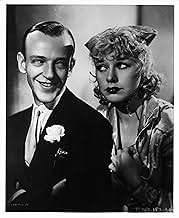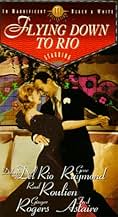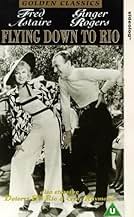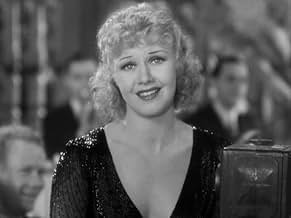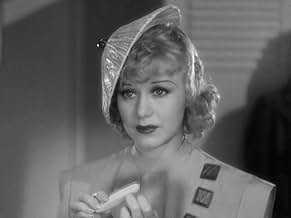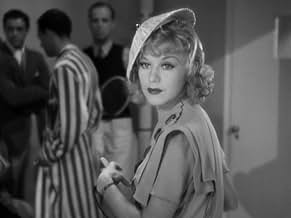NOTE IMDb
6,6/10
4,2 k
MA NOTE
Ajouter une intrigue dans votre langueA bandleader woos a Latin flame who is already engaged to his employer.A bandleader woos a Latin flame who is already engaged to his employer.A bandleader woos a Latin flame who is already engaged to his employer.
- Réalisation
- Scénario
- Casting principal
- Nommé pour 1 Oscar
- 1 victoire et 2 nominations au total
Dolores Del Río
- Belinha De Rezende
- (as Dolores Del Rio)
Luis Alberni
- Rio Casino Manager
- (non crédité)
Bernice Alstock
- Singer
- (non crédité)
Chita Andrews
- Check Girl
- (non crédité)
Avis à la une
Consider this. RKO released "Flying down to Rio" in 1933, when America was in the very depths of the Great Depression. Millions of Americans were out of work and millions more lived in fear of the economic and political realities plaguing the world.
So Hollywood turned out films like this one, escapist fare about rich dilettantes drifting back and forth from Miami to Rio. Indeed, the hero of this little trifle, Gene Raymond, is the scion of a wealthy family who will inherit lots of money, if he gives up fiddling around with song writing and aviation. And the thing is, pictures liked this one worked. The unemployed probably didn't have the ten cents or more it took to get in to see gems like this, but those who did have the money turned out for this kind of picture, gawking at the upper classes in wonder.
"Flying down to Rio," though, is an early talkie and hardly the best example of this kind of romantic comedy. Directed by Thornton Freeland, an early talkie director whose career was largely undistinguished, it has a loose feel about it and does not marry sound and visuals together with any real skill. The pacing is bad, the musical numbers drag on way too long and the film is not the kind of polished production RKO and the rest of Hollywood would start turning out within the next few years.
But "Flying Down to Rio" is remembered today for one thing and one thing only, the first pairing of Fred Astaire and Ginger Rogers, who would become the greatest dance team in movie history. That pairing almost didn't happen, because Ginger's role was originally earmarked for starlet Dorothy Jordan, who wound up catching the eye of Merian C. Cooper, then riding high at RKO after the spectacular success of "King Kong." Jordan became Cooper's girlfriend and quickly his wife and Ginger stepped into her dance shoes and from there into screen immortality. Ironically, Fred and Ginger are not the leads in this film and actually only do one dance number together, but they were good enough to convince the powers that be that new stars had been born, providing those stars could dance their way through their future films.
But aside from that number, there are a couple of other reasons to see this film. The first is top billed star Dolores Del Rio, one of the most beautiful women to ever turn up on the screen. A wealthy socialite from Mexico, she arrived in Hollywood in the silent era and became famous playing a French peasant girl being romanced by two American soldiers in "What Price Glory." Her transition to sound was rocky, though, not because of her voice, but rather what felled many a silent star, her "foreign accent." But it didn't kill her. She returned to Mexico and helped launch its film industry.
Aside from Del Rio, the other things to look for are the Depression era sets. Built to depict hotels and elaborate supper clubs, they are among the most spectacular of the era. And then, finally, there is that other sequence this film is known for, the truly amazing production number featuring the title song, "Flying Down to Rio" in which a bevy of beautiful girls allow themselves to be strapped to the wings of biplanes and flown over Rio as entertainment during the opening of a hotel. While the overwhelming majority of the footage are probably process shots, there appear to be a couple of real life wing walker type shots blended in to give the sequence a realistic feel.
Merian Cooper, then RKO's defacto production boss, was among many other things a pilot himself, an aviation buff and one of the founders of Pan American Airways, the airline that pioneered trans-ocean flight. And even before the famed Pan Am Clippers crossed the Atlantic and the Pacific in the mid-thirties, they'd already established mail and early passenger service to South America with the Sikorsky S-40 nd S-42 flying boats,shown at the end of the film.
In some ways, this film is one big advertisement for the Clippers and for aviation, back when it looked like fun. But then, the real fun was watching Astaire and Rogers in subsequent films proving that in addition to having a good eye for manly stuff like big gorillas and airplanes, Merian C.Cooper was not exactly blind to musical talent, either.
So Hollywood turned out films like this one, escapist fare about rich dilettantes drifting back and forth from Miami to Rio. Indeed, the hero of this little trifle, Gene Raymond, is the scion of a wealthy family who will inherit lots of money, if he gives up fiddling around with song writing and aviation. And the thing is, pictures liked this one worked. The unemployed probably didn't have the ten cents or more it took to get in to see gems like this, but those who did have the money turned out for this kind of picture, gawking at the upper classes in wonder.
"Flying down to Rio," though, is an early talkie and hardly the best example of this kind of romantic comedy. Directed by Thornton Freeland, an early talkie director whose career was largely undistinguished, it has a loose feel about it and does not marry sound and visuals together with any real skill. The pacing is bad, the musical numbers drag on way too long and the film is not the kind of polished production RKO and the rest of Hollywood would start turning out within the next few years.
But "Flying Down to Rio" is remembered today for one thing and one thing only, the first pairing of Fred Astaire and Ginger Rogers, who would become the greatest dance team in movie history. That pairing almost didn't happen, because Ginger's role was originally earmarked for starlet Dorothy Jordan, who wound up catching the eye of Merian C. Cooper, then riding high at RKO after the spectacular success of "King Kong." Jordan became Cooper's girlfriend and quickly his wife and Ginger stepped into her dance shoes and from there into screen immortality. Ironically, Fred and Ginger are not the leads in this film and actually only do one dance number together, but they were good enough to convince the powers that be that new stars had been born, providing those stars could dance their way through their future films.
But aside from that number, there are a couple of other reasons to see this film. The first is top billed star Dolores Del Rio, one of the most beautiful women to ever turn up on the screen. A wealthy socialite from Mexico, she arrived in Hollywood in the silent era and became famous playing a French peasant girl being romanced by two American soldiers in "What Price Glory." Her transition to sound was rocky, though, not because of her voice, but rather what felled many a silent star, her "foreign accent." But it didn't kill her. She returned to Mexico and helped launch its film industry.
Aside from Del Rio, the other things to look for are the Depression era sets. Built to depict hotels and elaborate supper clubs, they are among the most spectacular of the era. And then, finally, there is that other sequence this film is known for, the truly amazing production number featuring the title song, "Flying Down to Rio" in which a bevy of beautiful girls allow themselves to be strapped to the wings of biplanes and flown over Rio as entertainment during the opening of a hotel. While the overwhelming majority of the footage are probably process shots, there appear to be a couple of real life wing walker type shots blended in to give the sequence a realistic feel.
Merian Cooper, then RKO's defacto production boss, was among many other things a pilot himself, an aviation buff and one of the founders of Pan American Airways, the airline that pioneered trans-ocean flight. And even before the famed Pan Am Clippers crossed the Atlantic and the Pacific in the mid-thirties, they'd already established mail and early passenger service to South America with the Sikorsky S-40 nd S-42 flying boats,shown at the end of the film.
In some ways, this film is one big advertisement for the Clippers and for aviation, back when it looked like fun. But then, the real fun was watching Astaire and Rogers in subsequent films proving that in addition to having a good eye for manly stuff like big gorillas and airplanes, Merian C.Cooper was not exactly blind to musical talent, either.
This movie is typical of its time in the 'two guys and a girl' storyline, this time over the alluring Doleres del Rio (scarily, she looked much the same as this as Elvis Presley's mother in 'Flaming Star' years later). Gene Raymond plays the conniving bandleader who chases her from Miami to Rio, with an impromptu island stop en route.
There are some nice touches (the ghostly 'consciences' of Raymond and del Rio for one, the back projection of orchids and palm trees showcasing her thoughts as her local hick boyfriend sings 'Orchids in the Moonlight') but of course the real interest of this movie is for two reasons - one, the clever and inventive acrobatic stuff with the girls tied to aeroplane wings etc over a new nightspot; and two, the first screen teaming of Fred Astaire and Ginger Rogers, who light up the movie with 'The Carioca'. Fred may have been far from a looker but there is no denying his talent and there was certainly ample chemistry with Rogers for the teaming to work. They'd go on to brighter and better things through the 30s, but this film is fun.
There are some nice touches (the ghostly 'consciences' of Raymond and del Rio for one, the back projection of orchids and palm trees showcasing her thoughts as her local hick boyfriend sings 'Orchids in the Moonlight') but of course the real interest of this movie is for two reasons - one, the clever and inventive acrobatic stuff with the girls tied to aeroplane wings etc over a new nightspot; and two, the first screen teaming of Fred Astaire and Ginger Rogers, who light up the movie with 'The Carioca'. Fred may have been far from a looker but there is no denying his talent and there was certainly ample chemistry with Rogers for the teaming to work. They'd go on to brighter and better things through the 30s, but this film is fun.
The first pairing of Astaire and Rogers, playing second leads to Dolores DelRio and a slightly strabismic Gene Raymond. What music and what dancing!!! And the scenery of 1933 Rio is worth seeing. The story is slight, the acting is slighter but who cares when Astaire and Rogers take the floor for the Carioca. How silly is the concept of a bunch of girls strapped to the wings of airplanes performing over the hotel? But again, who cares?...it's history on film as the seminal appearance of the most famous dance team in the movies. The supporting players are good but what became of Raul Roulien?.....the rest are familiar to fans of old movies. Love the music,(even Orchids in the Moonlight)and especially the title tune which is rather forgotten now. Step back in time and enjoy this dated, but absolutely wonderful film. You won't be sorry and maybe you will dance the Carioca!!
There was a golden age of cinema lasting only four or five years - from the end of the silent era to the beginning of the Hays Code, the severe censorship rules which sought to turn cinema from naughty to nice, but in actuality sapped them of their truth and energy.
`Flying Down to Rio' is a classic pre-Hayes code talkie, and its characters have a quality of frankness which endears them to modern audience far more than many later films, whose stilted, conservative quality is somewhat alienating. You'd be surprised at what they could get away with in those days - it would be forty years before a film could get away with a line like that spoken by a starlet of her South American rivals - `What have those girls got below the equator that we haven't got?'
The film, about a love triangle between a Brazilian woman and two members of a swing band, is of course famous for two things - the slightly surreal sequence in which showgirls ride a biplane down to Rio in Busby Berkley-esque formation, and the debut of Fred Astaire and Ginger Rogers as a screen team. It's no wonder that audiences fell in love with the duo, whose `Carioca' is the highlight of the film.
They only made them like this for a little while - more's the shame!
`Flying Down to Rio' is a classic pre-Hayes code talkie, and its characters have a quality of frankness which endears them to modern audience far more than many later films, whose stilted, conservative quality is somewhat alienating. You'd be surprised at what they could get away with in those days - it would be forty years before a film could get away with a line like that spoken by a starlet of her South American rivals - `What have those girls got below the equator that we haven't got?'
The film, about a love triangle between a Brazilian woman and two members of a swing band, is of course famous for two things - the slightly surreal sequence in which showgirls ride a biplane down to Rio in Busby Berkley-esque formation, and the debut of Fred Astaire and Ginger Rogers as a screen team. It's no wonder that audiences fell in love with the duo, whose `Carioca' is the highlight of the film.
They only made them like this for a little while - more's the shame!
FLYING DOWN TO RIO (RKO Radio, 1933), directed by Thornton Freeland, is a musical showcase for Mexican star Dolores Del Rio playing a Brazilian beauty named Belinia De Rezende, Gene Raymond as Roger Bond, a girl chasing orchestra leader, and Raul Roulien as Julio Rubeiro as Belinia's fiancé and Roger's best friend who complicates matters. By the film's conclusion, the ones who "walked off" with the movie are the supporting players of Ginger Rogers as the band vocalist, and Fred Astaire as the accordionist-dancer, in that order, thus, the beginning of a new screen team, and never again in the persona of sassy Honey Hale and semi-sophisticated Fred Ayres. Yet it's amazing that Astaire and Rogers made such a lasting impression at all in this production, considering they play subordinate roles who supply "comedy relief," and have very little opportunity to act or dance together. Even in the famous, "Carioca," number (which was how they became crowned "The King and Queen of the Carioca"), they get to perform only a few dance steps, but the ensemble of other dancers and singers get most of the footage during its 12 minutes. But even without Astaire and Rogers, or either with one of them along with a different partner, FLYING DOWN TO RIO remains an early musical attempt to capture that South American feel and tango rhythm, predating all those cliché musicals MGM or 20th Century-Fox would distribute in the 1940s, with the addition of Technicolor and/or Xavier Cugat and Carmen Miranda, etc. As for the plot elements, it remains similar to the ones used in subsequent Astaire and Rogers films, but this time the situations of strangers meeting followed by a merry mix-up, belongs to its leading players (Del Rio, Raymond and Roulien). The first half of the movie takes place in Miami, Florida, where the plot development amongst the central characters begin, then shifts to Rio De Janiero, the second largest city in Brazil, where the complications continue and are resolved after 89 minutes of screen time. In between all this comes the singing and dancing to help the plot along.
With the music and lyrics by Gus Kahn, Edward Eliscu and Vincent Youmans, the songs include: "Music Makes Me" (sung by Ginger Rogers in the foreground with Fred Astaire, as one of the members of the band, playing the accordion in the background); "The Carioca" (performed by musicians, danced by numerous Brazilians, sung by Movita and Etta Moten, and danced briefly by Astaire and Rogers); "Orchids in the Moonlight" (sung by Raul Roulien to Dolores Del Rio/reprise, danced by Astaire and Del Rio, with one observer saying to another, "Oh, look, Belinha is dancing our tango with an Americano."); "Music Makes Me" (tap dance solo by Astaire); and "Flying Down to Rio" (sung by Fred Astaire/ danced by girls chained to the wings of the flying airplanes).
Other than some advanced camera techniques used in this production, portions of the movie play like a picture postcard advertisement, mainly during its montage sequences where the camera focuses first from an air-view of famous landmarks, then from the ground view of Rio De Janiero, and flipping over to other scenes of the city from people walking the streets to cars driving down the roads before returning to the storyline.
In the supporting cast are Blanche Frederici as Belinda's old-fashioned Aunt (Tia) Elena; Roy D'Arcy, Maurice Black and Armand Kaliz (The Greeks); Franklin Pangborn (Mr. Hammerstein); Luis Alberni (The Rio Casino Manager); and Eric Blore (Mr. Butterbass), making his first of five performances in an Astaire and Rogers musical. He is an asset to every one of them. It's also interesting to note that Raul Roulien remained somewhat obscure after appearing in this, never to become the Cesar Romero-type of Hollywood. As for the few Hollywood movies to feature him in the early 1930s, this is the only one still in circulation today and possibly his best opportunity on screen.
When Gene Raymond was interviewed about FLYING DOWN TO RIO in the documentary on RKO Radio titled "Hollywood, the Golden Years" (as narrated by Ed Asner back in the late 1980s), he mentioned that he thought that FLYING DOWN TO RIO was going to become the "Bomb of Bombs," but much to his surprise when it made its premiere during the Christmas season at Radio City Music Hall, he noticed while being in New York City that there was a long line of people going around the block waiting to go in and see this movie. One cannot be sure that history would repeat itself again in today's society, but FLYING DOWN TO RIO, in spite of whatever is right or wrong it it, is vintage entertainment at best. Only one debit: acrobats flipping and catching one other, and hanging on the swings under the wings of the flying airplane during the "Flying Down to Rio" number. Not realistic, but it got by. And on the historical side, this is where Astaire and Rogers got their start together on screen, thus, becoming the most popular song and dance team of the movies, never to be topped or equaled by anyone. Now that's something to think about!
FLYING DOWN TO RIO, which was formerly shown on American Movie Classics for many years, is currently presented on Turner Classic Movies. It is also available on video cassette and DVD. Recommended highly to fans of the team and/or musicals from this era. (***1/2)
With the music and lyrics by Gus Kahn, Edward Eliscu and Vincent Youmans, the songs include: "Music Makes Me" (sung by Ginger Rogers in the foreground with Fred Astaire, as one of the members of the band, playing the accordion in the background); "The Carioca" (performed by musicians, danced by numerous Brazilians, sung by Movita and Etta Moten, and danced briefly by Astaire and Rogers); "Orchids in the Moonlight" (sung by Raul Roulien to Dolores Del Rio/reprise, danced by Astaire and Del Rio, with one observer saying to another, "Oh, look, Belinha is dancing our tango with an Americano."); "Music Makes Me" (tap dance solo by Astaire); and "Flying Down to Rio" (sung by Fred Astaire/ danced by girls chained to the wings of the flying airplanes).
Other than some advanced camera techniques used in this production, portions of the movie play like a picture postcard advertisement, mainly during its montage sequences where the camera focuses first from an air-view of famous landmarks, then from the ground view of Rio De Janiero, and flipping over to other scenes of the city from people walking the streets to cars driving down the roads before returning to the storyline.
In the supporting cast are Blanche Frederici as Belinda's old-fashioned Aunt (Tia) Elena; Roy D'Arcy, Maurice Black and Armand Kaliz (The Greeks); Franklin Pangborn (Mr. Hammerstein); Luis Alberni (The Rio Casino Manager); and Eric Blore (Mr. Butterbass), making his first of five performances in an Astaire and Rogers musical. He is an asset to every one of them. It's also interesting to note that Raul Roulien remained somewhat obscure after appearing in this, never to become the Cesar Romero-type of Hollywood. As for the few Hollywood movies to feature him in the early 1930s, this is the only one still in circulation today and possibly his best opportunity on screen.
When Gene Raymond was interviewed about FLYING DOWN TO RIO in the documentary on RKO Radio titled "Hollywood, the Golden Years" (as narrated by Ed Asner back in the late 1980s), he mentioned that he thought that FLYING DOWN TO RIO was going to become the "Bomb of Bombs," but much to his surprise when it made its premiere during the Christmas season at Radio City Music Hall, he noticed while being in New York City that there was a long line of people going around the block waiting to go in and see this movie. One cannot be sure that history would repeat itself again in today's society, but FLYING DOWN TO RIO, in spite of whatever is right or wrong it it, is vintage entertainment at best. Only one debit: acrobats flipping and catching one other, and hanging on the swings under the wings of the flying airplane during the "Flying Down to Rio" number. Not realistic, but it got by. And on the historical side, this is where Astaire and Rogers got their start together on screen, thus, becoming the most popular song and dance team of the movies, never to be topped or equaled by anyone. Now that's something to think about!
FLYING DOWN TO RIO, which was formerly shown on American Movie Classics for many years, is currently presented on Turner Classic Movies. It is also available on video cassette and DVD. Recommended highly to fans of the team and/or musicals from this era. (***1/2)
Le saviez-vous
- AnecdotesStanding outside a bakery shop in Rio, Ginger Rogers asks, "Oh, Freddie, how do you ask for little tarts in Portuguese?" Fred Astaire replies, "Don't heckle me, try the Culbertson System." This pre-Code, double entendre joke would have been funny to Depression-era audiences, for whom bridge was a common pastime. Ely Culbertson was a champion bridge player and worldwide celebrity, who had won several international tournaments by developing a rather aggressive bidding system. He was also notorious for his sexual exploits. His 1940 autobiography was banned in many countries. In the 1930s, the word "tart" was equivalent to "slut" or "whore". Also, in the opening inspection of hotel staff, the boss sees a maid whose shoe heels are oddly beveled and says he will not tolerate that sort of thing. A "round-heeled woman" was 1930s slang for a prostitute, a woman who could tilt easily from standing to being on her back.
- GaffesFrom the height they were flying, most of the "dance" routines of the young women on the plane wings would not be visible to people on the ground.
While true, this observation is not a Goof. The purpose of the event likely was more for advertising or Newsreel value, or even simply "bragging rights".
- Citations
Belinha's Friend: What have these South Americans got below the equator that we haven't?
- ConnexionsFeatured in Hollywood and the Stars: The Fabulous Musicals (1963)
- Bandes originalesMusic Makes Me
(1933) (uncredited)
Music by Vincent Youmans
Lyrics by Gus Kahn and Edward Eliscu
Performed by Ginger Rogers
Meilleurs choix
Connectez-vous pour évaluer et suivre la liste de favoris afin de recevoir des recommandations personnalisées
- How long is Flying Down to Rio?Alimenté par Alexa
Détails
Box-office
- Budget
- 462 000 $US (estimé)
- Durée
- 1h 29min(89 min)
- Couleur
- Rapport de forme
- 1.37 : 1
Contribuer à cette page
Suggérer une modification ou ajouter du contenu manquant


